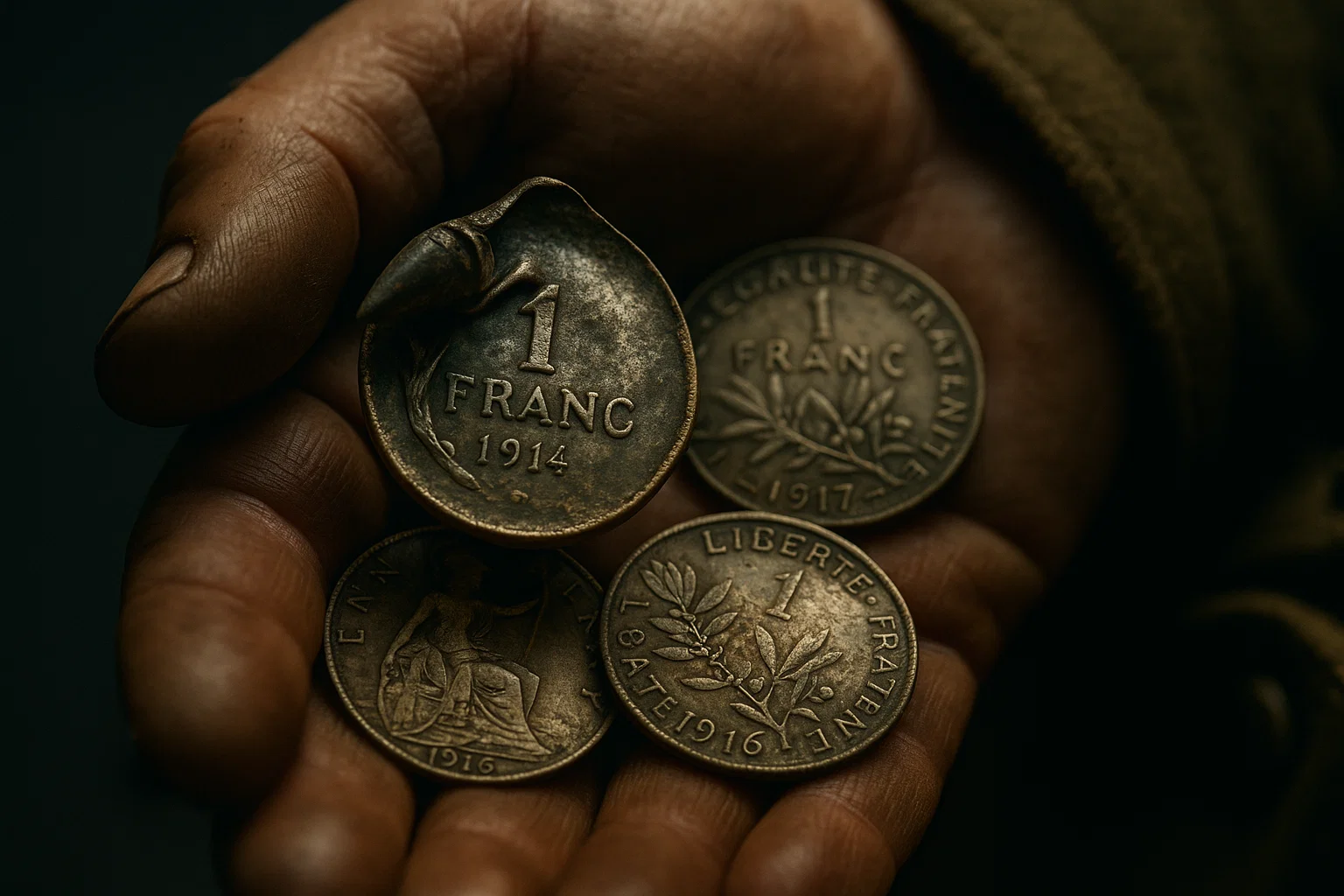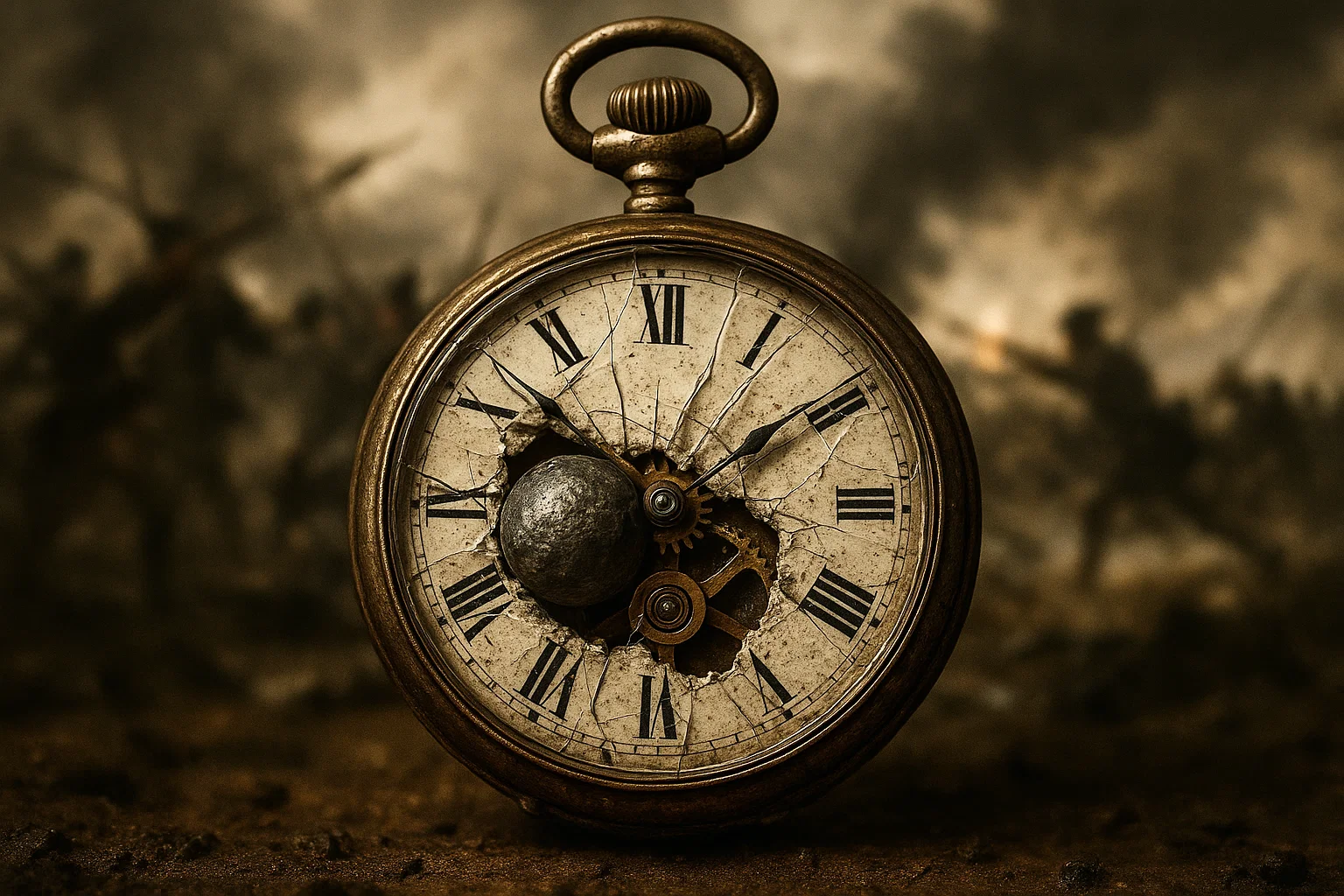Our daily lives are woven from countless threads of coincidence. Most are so trivial they pass unnoticed, yet some… some possess the astonishing power to alter a life, or even to snatch it back from the very brink of annihilation.
In this article, we journey into the extraordinary. We will explore 14 true stories of survival so incredible they challenge our understanding of probability, stories that feel less like random chance and more like the deliberate intervention of fate itself. Are these mere statistical anomalies? Or are we glimpsing the workings of an unseen hand?
- The Soldier’s Pocket Change (Adrien Fournier)
- The Man Who Survived Two Apocalypses (Tsutomu Yamaguchi)
- The Woman Struck by a Star (Ann Hodges)
- The Cyclist Who Cheated Death Twice (Maarten de Jong)
- The Wrong Turn That Started a World War (Franz Ferdinand)
- The Three Mr. Binghams of Peru
- The Unlikely Catcher (Joseph Figlock)
- The Novel That Predicted Disaster (Morgan Robertson)
- The Cancelled Passages (The Titanic’s “Missed” Victims)
- The Twin’s Premonition
- The Woman Who Fell 33,000 Feet (Vesna Vulović)
- The Man Who Cheated Fate Seven Times (Frane Selak)
- The Choir Practice That Saved a Congregation
- The Book That Stopped a Bullet (Multiple Soldiers)
The Soldier’s Pocket Change (Adrien Fournier)

The trenches of World War I were a factory of death, a muddy, blood-soaked landscape where life was measured in minutes. For French soldier Adrien Fournier, his minute had seemingly come. During a brutal exchange, an enemy bullet found him, striking him square in the chest.
But Fournier did not fall. He did not bleed. The bullet, aimed directly at his heart, had been stopped. The savior? A stack of six coins—simple, everyday francs—that he happened to have in his breast pocket.
His comrades, upon finding him stunned but alive, retrieved the coins. The final piece of metal was hideously deformed, having absorbed the full, lethal impact. Had he carried one less coin, had he spent them the day before, had he placed them in another pocket… the story would have ended differently. It was, quite literally, a fortune that saved his life.
We often hear of “lucky charms,” but for Fournier, the abstract concept of luck materialized into a tangible, life-saving shield. One can only imagine him clutching those bent coins for the rest of his days, a permanent reminder of the razor-thin line between his life and the abyss.
The Man Who Survived Two Apocalypses (Tsutomu Yamaguchi)
In the grim ledger of human history, does any name bear witness to such a devastating miracle as Tsutomu Yamaguchi? In August 1945, Mr. Yamaguchi, an engineer, was on a business trip in Hiroshima. On August 6th, he was walking to the shipyard when the sky tore open. The atomic bomb “Little Boy” detonated, less than two miles from him.
He was thrown to the ground, his eardrums ruptured, his upper body scorched by the blast. Yet, miraculously, he survived. After spending a night in a shelter, wounded and disoriented, he made a decision: he had to go home. He journeyed back to his wife and child in his hometown of… Nagasaki.
He arrived on August 8th. On August 9th, while describing the unbelievable horror of the Hiroshima blast to his skeptical boss, the sky once again turned to blinding white light. The “Fat Man” bomb detonated. He was, again, just under two miles from the epicenter.
Incredibly, he, his wife, and his child all survived this second nuclear holocaust. To endure one apocalypse is unthinkable. To endure two, in the span of three days, and live to tell the tale, is a fate so cruel and so miraculous that it defies all language. Mr. Yamaguchi later became a vocal advocate for nuclear disarmament, his life a testament to both human folly and inexplicable resilience.
The Woman Struck by a Star (Ann Hodges)

On November 30, 1954, Ann Hodges of Sylacauga, Alabama, was doing what many of us do: napping on her living room sofa. Her afternoon slumber was shattered by a deafening explosion.
She awoke in a cloud of dust and debris, confused and in pain. Something had crashed through her roof, ricocheted off her large console radio, and struck her on the hip. The object was a black, 8.5-pound rock. But it was not from this Earth.
It was a meteorite. Ann Hodges holds the unique and terrifying distinction of being the only person in recorded history to be directly struck by an extraterrestrial object. The impact left a massive, pineapple-shaped bruise, but she was, astonishingly, not seriously injured.
The odds of being hit by a meteorite are astronomical, far lower than winning the lottery. For Ann, it was a painful, terrifying, and utterly singular event—a cosmic game of pinball where she was the target, and yet, a game she managed to walk away from. The universe, it seems, has a very strange, and very precise, sense of humor.
The Cyclist Who Cheated Death Twice (Maarten de Jong)
If you were scheduled to be on a flight that vanished, you would count yourself the luckiest person alive. If you were then scheduled for *another* flight that was shot down, and you missed that one too… what would you call yourself?
Dutch professional cyclist Maarten de Jong knows this feeling. In 2014, he was booked to fly on Malaysia Airlines Flight MH370, the plane that mysteriously vanished over the Indian Ocean. At the last minute, he changed his ticket for a flight that was one hour earlier and, crucially, cheaper. He saved a few euros and, in doing so, saved his life.
The cycling world was stunned by his close call. But just four months later, de Jong was scheduled to fly again, this time to return to his home in the Netherlands. His flight? Malaysia Airlines Flight MH17, which was tragically shot down over Ukraine. Once again, seeking to save money for his travel back, he found a different, cheaper flight at the last minute.
Two of the 21st century’s most infamous aviation disasters. He was scheduled to be on both. He missed both because he was, by his own admission, “a bit of a cheapskate.” It’s a chilling reminder that sometimes, the most mundane and trivial decisions—like trying to save a few bucks—can have world-altering, life-saving consequences.
The Wrong Turn That Started a World War (Franz Ferdinand)
Sometimes, a coincidence doesn’t save a life but ends one—and in this case, it set in motion a chain of events that cost millions of lives. On June 28, 1914, in Sarajevo, Archduke Franz Ferdinand of Austria-Hungary was the target of an assassination plot.
The first attempt that day failed. A would-be assassin threw a bomb at the Archduke’s motorcade, but it bounced off his car and exploded under the vehicle behind, injuring several people. The Archduke was shaken but unharmed.
The motorcade sped away. Later that day, the Archduke decided to visit the injured officers in the hospital. His driver, new to the city, was not informed that the route had been changed for safety. He took a wrong turn, driving down Franz Joseph Street.
Realizing his mistake, the driver stopped the car to turn around. He stopped directly in front of a delicatessen. Standing right there, having given up on the failed plot, was another assassin, 19-year-old Gavrilo Princip. Stunned by his impossible luck, Princip stepped forward, drew his pistol, and fired. The rest is history: the assassination triggered the complex web of alliances that ignited World War I. An entire century’s history, dictated by a single, fatal wrong turn.
The Three Mr. Binghams of Peru
This story sounds like the setup to a vaudeville joke, but it’s a documented and bizarre case from the 1920s. Three British men were traveling independently on a train from Peru. They found themselves sharing a carriage and, as travelers do, struck up a conversation.
They introduced themselves. The first man’s name was Mr. Bingham. The second, to their mutual amusement, was also named Mr. Bingham. The third man, arriving late, declared with astonishment that his name, too, was Mr. Bingham. They were three complete strangers, all with the same surname, all in the same carriage on the same train in rural Peru.
The coincidences, however, were just getting started. As they talked, they discovered that all three had been working at the British consulate in Lima. But the truly baffling part? They were all traveling home because they had *all* contracted the same rare, debilitating illness. This chance meeting allowed them to compare notes on their symptoms and treatments, a crucial exchange of information at a time when medical knowledge was limited. Their bizarre, tripartite meeting may very well have been the key to their collective recovery.
The Unlikely Catcher (Joseph Figlock)

Fate, it seems, has a flair for repetition. In 1930s Detroit, a street sweeper named Joseph Figlock was going about his daily duties. As he was working, a baby fell from a fourth-story window, landing directly on Figlock.
The impact was staggering, but Figlock’s body—and perhaps a healthy dose of sheer luck—cushioned the fall. Both he and the baby were stunned but, miraculously, unharmed. A life saved. A one-in-a-million event. The story would be incredible enough if it ended there.
It does not. Almost exactly one year later, Figlock was sweeping an alley. Not just a similar alley—the *same* alley. As he passed under the *same* window, the very *same child* fell once again. And once again, the child landed on Joseph Figlock. And once again, both survived the incident without serious injury.
The odds of this are simply not calculable. It’s a story that defies logic, a cosmic alignment so absurd it borders on the divine. Was Figlock a guardian angel, or just the unluckiest, luckiest man in Detroit?
The Novel That Predicted Disaster (Morgan Robertson)
In 1898, 14 years before the RMS Titanic set sail, an American author named Morgan Robertson published a novella titled “Futility, or the Wreck of the Titan.”
The book described a fictional ocean liner, the “Titan,” which was, at the time, the largest ship ever built. It was described as “unsinkable.” The plot? This magnificent ship, on its maiden voyage in April, strikes an iceberg in the North Atlantic and sinks. Because the ship was deemed “unsinkable,” it did not carry enough lifeboats for its thousands of passengers, leading to catastrophic loss of life.
Let that sink in. The similarities are uncanny, chilling:
- **Ship Name:** Titan vs. Titanic
- **Nickname:** “Unsinkable”
- **Time of Year:** April
- **Cause of Sinking:** Iceberg in the North Atlantic
- **Fatal Flaw:** Not enough lifeboats
When the Titanic sank in 1912, Robertson’s obscure book was rediscovered, shocking the world. Was it a premonition? A warning from the future? Or was it simply a case of a knowledgeable maritime author (Robertson had experience at sea) understanding that the hubris of building such massive ships without adequate safety measures would inevitably lead to tragedy? We will never know, but “Futility” remains one of history’s most haunting literary coincidences.
The Cancelled Passages (The Titanic’s “Missed” Victims)
The sinking of the Titanic was a tragedy, but for a fortunate few, it was a tragedy they narrowly avoided through sheer, dumb luck. The list of those who were booked to sail on that maiden voyage but cancelled at the last minute is astonishing.
Milton Hershey, the founder of the Hershey’s chocolate empire, had a first-class cabin reserved. He and his wife had been in France and were set to return home on the new liner. However, business called, and he had to attend to matters in America sooner. He cancelled his Titanic ticket and took an earlier, less glamorous ship. Had he not, the world might never have known the Hershey’s Kiss.
Others who dodged that fateful iceberg include Guglielmo Marconi, the inventor of the radio, who was offered a free passage but chose to sail three days earlier. Financier J.P. Morgan, whose company actually owned the Titanic, was set to be aboard for the maiden voyage but cancelled due to illness. Their lives, and the future of technology and finance, were saved not by heroism, but by a cough, or a busy schedule.
The Twin’s Premonition
The bond between twins is often described as something mystical, a connection that transcends ordinary understanding. This story, a piece of modern folklore that has resonated for its powerful simplicity, illustrates why.
In the UK, a young woman suddenly cried out, clutching her chest in unbearable pain. She was rushed to the hospital, but doctors were baffled. Her heart was fine. Her lungs were clear. There was absolutely nothing physically wrong with her. Yet, she was convinced she was dying.
At that exact moment, miles away, her twin brother—serving in the military—had been shot in the chest during a live-fire training exercise. The bullet had struck him in the same place his sister felt the pain. The “warning” she received, this phantom agony, allowed the family to be notified and react immediately, arguably aiding in his survival and recovery. It’s a story that science cannot explain, a testament to a human connection that defies our current understanding of time, space, and empathy.
The Woman Who Fell 33,000 Feet (Vesna Vulović)

On January 26, 1972, JAT Flight 367, a flight from Copenhagen to Belgrade, was cruising at 33,330 feet (over 10,000 meters) when a bomb, hidden in a suitcase, detonated. The plane was torn apart over the snowy mountains of Czechoslovakia.
There were 28 people on board. There should have been no survivors. And yet, a 22-year-old flight attendant named Vesna Vulović was found alive in the wreckage. She had been trapped in the tail section, which plummeted to earth, crashing into a steep, snow-covered mountainside. The snow cushioned the impact, and her history of low blood pressure (a condition that should have barred her from flying) may have caused her to pass out quickly, saving her heart from exploding on impact.
She fell 33,330 feet—the highest fall survived without a parachute, a record that stands to this day. Her injuries were catastrophic: a fractured skull, two broken legs, a crushed pelvis, and three broken vertebrae that left her temporarily paralyzed. But she did not die. She eventually made a near-full recovery and became a national hero in Yugoslavia. Her survival is a cocktail of one-in-a-billion chances, a true miracle of physics, biology, and pure, inexplicable luck.
The Man Who Cheated Fate Seven Times (Frane Selak)

If you think Maarten de Jong was lucky, you haven’t heard of Frane Selak. This Croatian music teacher’s life reads like a script for a Final Destination movie, only in reverse. He is often called the “world’s unluckiest lucky man.”
His story begins in 1962, when a train he was on derailed and plunged into an icy river. 17 passengers died. Selak swam to safety with a broken arm and hypothermia.
A year later, he was on his first and only plane ride. A door blew off mid-flight, and he was sucked out of the plane without a parachute. The plane crashed, killing 19. Selak landed in… a haystack. He survived.
Three years after that, a bus he was on skidded off a bridge into a river. Four people drowned. Selak swam away with minor cuts.
The list goes on. His car caught fire *twice*. He was hit by a bus. He avoided a head-on collision only to be thrown from his car as it fell off a cliff (he clung to a tree). After surviving *seven* distinct, fatal disasters, life seemed to decide it had tested him enough. In 2003, two days after his 73rd birthday, he bought a lottery ticket for the first time. He won $1.1 million. He used it to build a shrine to the Virgin Mary to give thanks.
The Choir Practice That Saved a Congregation
This is a story of collective, small-scale miracles. In Beatrice, Nebraska, on the evening of March 1, 1950, the 15 members of the West Side Baptist Church choir were scheduled to meet for practice at 7:25 PM.
For 15 different reasons, every single one of them was late.
- One member was finishing a homework assignment.
- Two sisters were delayed because their car wouldn’t start.
- The pastor and his family were late because his wife was ironing his daughter’s dress.
- One woman fell asleep after dinner.
Individually, these are the mundane, everyday annoyances that make us check our watches. But collectively? At 7:27 PM, just two minutes after practice was supposed to start, the church… exploded. A massive natural gas leak had filled the building, and it detonated with enough force to level the entire structure.
The choir, the pastor, and their families—all of whom should have been inside—were instead standing safely outside, arriving late, one by one, to stare in horror at the smoldering ruins of the building they were meant to be in. Not one member was injured. It’s a powerful story of how simple, everyday tardiness can, on rare occasions, be a divine form of salvation.
The Book That Stopped a Bullet (Multiple Soldiers)
This story, much like the soldier’s coins, has repeated itself so many times in history that it has become its own archetype. It is the story of the “Soldier’s Bible.”
Perhaps the most famous account comes from the American Civil War. Private John M. “Johnnie” Adams of the 12th Iowa Infantry was in the thick of the Battle of Shiloh. A Confederate musket ball struck him in the chest. His comrades saw him fall and assumed he was dead. But he rose, pulling from his coat pocket a small, leather-bound Bible his mother had given him. The musket ball was lodged deep within the pages of the Old Testament. The book, and the faith it represented, had physically saved his life.
This is not an isolated incident. Similar stories emerged from World War I, where soldiers’ lives were saved by Bibles, or even thick books of poetry, placed in their breast pockets. In a more modern context, a US soldier in Iraq was saved when an insurgent’s bullet was stopped by the small copy of the “Soldier’s Prayer Book” he carried. Each instance is a powerful, tangible intersection of faith and fate, where the “word of God” became a literal shield against death.
Coincidence, Fate, or Something Else?

So, what are we to make of these tales? The soldier’s coins, the double-survivor of the atomic bomb, the woman who fell from the sky, the man who couldn’t be killed…?
A statistician might tell you that with billions of people living out trillions of moments, even the most improbable events are bound to happen eventually. A philosopher might speak of destiny, of threads woven into a grand design. A cynic might just call it “dumb luck.”
But as I’ve collected these stories, I can’t help but feel a sense of awe. They remind us that the world is a far stranger, more mysterious, and more miraculous place than we often give it credit for. They remind us that even in our darkest moments, the impossible can happen. Perhaps you have a story of your own—a “what if” moment that sends a shiver down your spine. Perhaps the truth is simply that life itself, in all its beautiful, terrifying unpredictability, is the greatest coincidence of all.


コメント